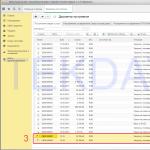A monitor is present in almost every home and is an integral part of our lives. But there are situations when the computer does not see the monitor and you need to quickly solve this problem, but first you need to find out the reason for this situation. There can be a huge number of reasons, for example, problems with motherboard, video card, or lack of RAM or broken monitor cable.
Now we will look in detail at the main causes of this problem and solutions.
Checking cables
First of all, pay attention to the cable; it can be VGA, HDMI or DVI, depending on the type of monitor. Inspect it for breaks or compression.
![]()
If you have a spare cable at home, try connecting it. And then it will immediately become clear whether the problem is with the cable or not.
Sometimes it happens that you have a dedicated video card, and the monitor cable is connected to the connector motherboard. Therefore, you need to check the correct connection and connect it to the video card itself.
Another point is that the power cable may be faulty or loose. To do this, you need to see if the indicator light on the monitor is on. If the indicator does not light, try pressing the monitor's on/off button.
![]()
Processor failure
One of possible malfunctions The processor may fail. When this happens, there is no image on the monitor, but the motherboard should make a few noises when you turn on the computer. sound signals, which indicate problems with the processor.
Video card malfunction
You can check the serviceability of a video card quite simply; to do this, you need to connect it to a known-good system unit with a working motherboard.
![]()
In addition, when the video card fails, when turned on, the computer will emit several sound signals, since self-diagnosis of all components occurs at startup.
If your computer is several years old, you can use an eraser to clean the contacts of the video card, while disconnecting it from the PC.
RAM is faulty
Another reason could be RAM. To check its functionality, simply remove the memory module and insert it into the adjacent slot. The ideal option would be to install a known-good module.
![]()
Screen resolution
Such problems can also occur due to resolution mismatch, for example, the monitor does not support the required resolution due to its obsolescence or other problems. In this case, a black screen may appear or periodic shutdowns may occur.
The PC “does not see” the second monitor: check the cable
If the computer does not detect the second monitor after connecting, first check whether the cable with which you are trying to connect the monitor to yours is working properly. system unit. Connect your monitor to your computer using a different cable if you have multiple monitor cables.
If the screen worked, then most likely the problem was a malfunction of the second wire, which can be safely disposed of.
If, on the other hand, the screen still does not work, the problem may be with your PC's video output or incorrect system settings. The PC “does not see” the second monitor: check the video output
If your second monitor has different interfaces, check whether it can be connected, for example, via HDMI instead of a VGA connector. Alternatively, you can try using other available interfaces on your computer, or try connecting via a VGA-HDMI or DVI-HDMI adapter. The last option is relevant if the monitor does not have an HDMI connector, but the PC does. As a rule, computers are equipped with several video outputs: the most common are VGA, DVI and HDMI. Try all of them using the appropriate cable types.
Attention: you can often find several outputs of the same type on a computer. If you connected your second screen, for example, to the VGA output, check if there is another one that is equally free. Try moving the cable to an alternative output and check if the monitor is recognized.
If even after these manipulations you do not see the picture on the monitor, perhaps the problem lies in connecting the cable to the integrated graphics card, which is deactivated by default, since the image from the dedicated card is displayed on the monitor. In the photo you see just such a case: the right connectors belong to the graphics card (highlighted in red), while the left ones belong to the motherboard. Since the integrated video system is deactivated by default in this situation, you can only receive images from the outputs offered by the dedicated graphics card. The PC “does not see” the second monitor: enable detection of the second monitor in the system settings
Another reason for the second monitor not being recognized may be incorrect system settings on your computer. In this case, follow the instructions below to combine the second monitor with your computer: Go to Control Panel, select the option All Control Panel Items | Screen | Screen Resolution" and click the "Define" button
Just a few years ago, a second monitor for a computer was considered something strange and special. Today, computer installations with two and more monitors are widely used in various fields of activity. Programmers, architects, designers, employees of financial institutions, and even ordinary users prefer two monitors for convenient organization of their workspace.
But what if you decide to buy another monitor to accommodate 30+ tabs with social networks, A it is not detected by the computer? This happens sometimes, and we have several ways to solve this problem.
Why doesn't Windows see the second monitor?
In this article you will learn what to do if The computer does not see the second monitor. We will only touch on the Windows platform, and wish users good luck in finding a solution to the problem :)
Port
The first step is to determine whether everything is ok with the connection and whether an additional monitor is connected to the right port. If you have discrete video card, all graphics output ports are located on it. This means that any monitor cables (VGA, DVI..) you connect to the motherboard will not work. Make sure that the cable is connected to the graphics adapter port.
If you want to use the motherboard and video card ports at the same time (for example, if the video card does not have VGA, but you need to connect VGA and HDMI), you need to go into the BIOS and set the integrated adapter as primary. Video adapter drivers must provide simultaneous support for the motherboard and graphics card ports.
Force search for additional monitors in Windows
Most displays are automatically detected by Windows when connected, and Win + P allows you to control them. However, there are times when Windows doesn't see second monitor. This may be due to an outdated secondary display model, or problems with /. (Don't forget to clean the system from time to time using)

To have Windows detect the second monitor, click right click mouse on the desktop, click Display Settings, then the Detect button under Multiple Displays.
Reinstalling or Rolling Back the Graphics Card Driver
If the problem appears after the next driver update, you need to roll back to an older version.

Go to Device Manager and find your video card in the “Video Adapters” section. Then right-click on it, go to Properties, and open the “Driver” tab. Click “Roll Back” and follow the instructions. After restarting your computer, your second monitor should work. You can also update the driver to latest version. To work with drivers, we recommend using .
You can also follow the above steps for an additional monitor (in the “Monitors” section of Device Manager)
Bottom line
We have given several ways to fix the problem with the add-on not working. display. If your the computer still does not see the second monitor, it is worth checking the functionality of the latter. Connect it instead of the main screen and make sure it works as it should. I wish you good luck.




